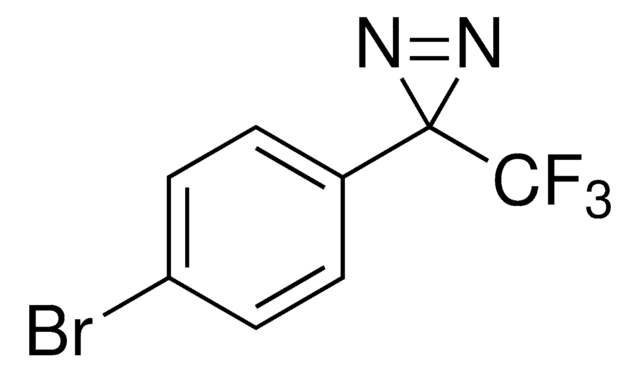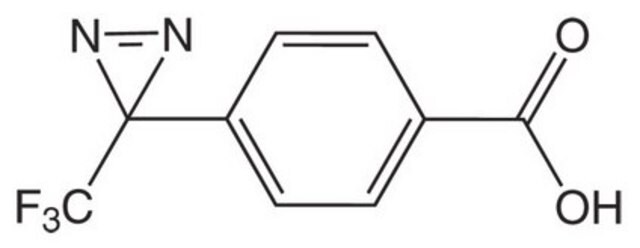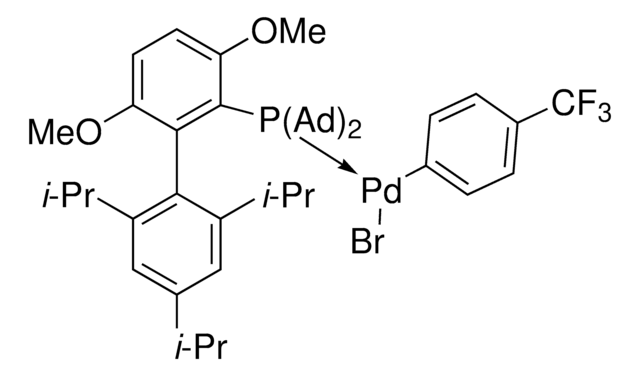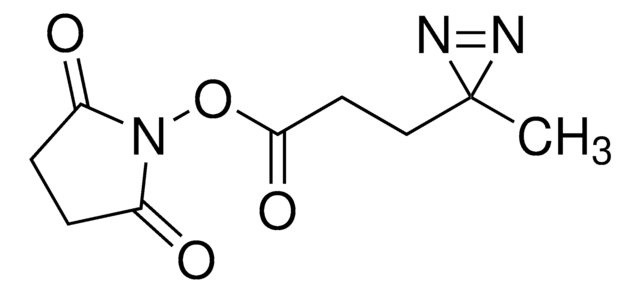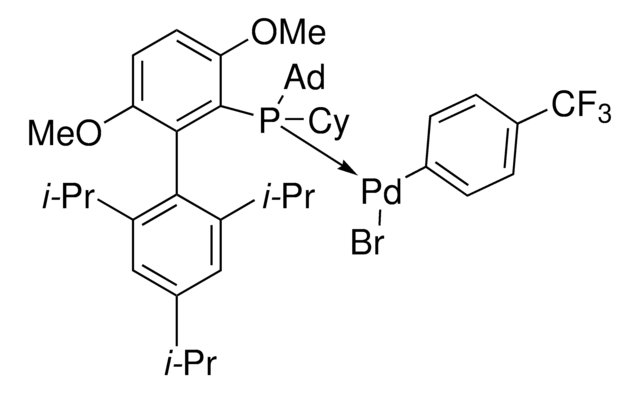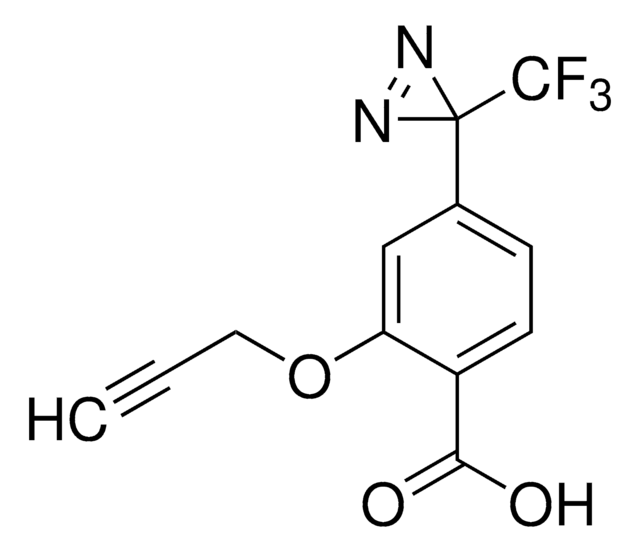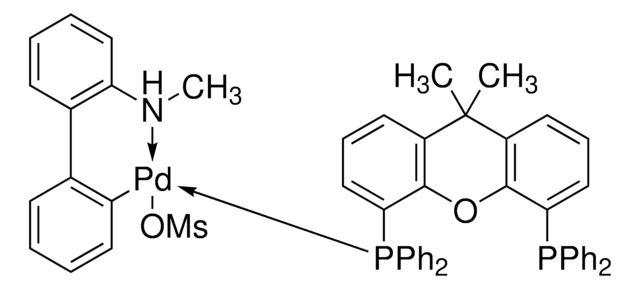Wszystkie zdjęcia(1)
Kluczowe dokumenty
921726
Bis-Diazirine polymer crosslinker
Synonim(y):
3,3′-((perfluoropropano-2,2-diilo)bis(4,1-fenyleno))bis(3-(trifluorometylo)-3H-diazyryna), BondLynx Gen-I
Zaloguj sięWyświetlanie cen organizacyjnych i kontraktowych
About This Item
Wzór empiryczny (zapis Hilla):
C19H8F12N4
Numer CAS:
Masa cząsteczkowa:
520.27
Numer MDL:
Kod UNSPSC:
12161502
Polecane produkty
temp. przechowywania
2-8°C
Poziom jakości
Zastosowanie
Ta cząsteczka bis-diazyny została zaprojektowana do kowalencyjnego sieciowania materiałów o niskiej energii powierzchniowej (niefunkcjonalizowanych) poprzez tworzenie wysoce reaktywnych karbenowych związków pośrednich, które wstawiają się w wiązania C-H na sąsiednich powierzchniach polimerowych, gdy są aktywowane umiarkowanym ciepłem lub światłem ~350nm.
Nasza cząsteczka bis-diazyny umożliwia niezwykle wydajne i stabilne perowskitowe ogniwa słoneczne. Badanie wykazało, że przyczynia się ona do zachowania prawie 99% ich początkowej wydajności nawet po 1000 godzin ciągłego oświetlenia. Przy stałej temperaturze (60°C) ogniwa PSC poddane działaniu bis-diazyny zachowały niemal 98% sprawności po 600 godzinach ciągłej pracy, podczas gdy ogniwa niepoddane obróbce straciły 27% sprawności w tych samych warunkach. Ogólnie rzecz biorąc, PSC poddane działaniu bis-diazyny osiągnęły wysoką certyfikowaną wydajność ponad 24% przy długiej stabilności operacyjnej ponad 1000 godzin.
Ponadto może być stosowany w klejach i do wzmacniania tekstyliów. Diazirynowe środki sieciujące nie rozróżniają podłoży polimerowych i mogą być stosowane do łączenia różnych materiałów, takich jak PP i PE, w sztywne tworzywa termoutwardzalne. Wykazano, że wiążą ze sobą polipropylen, polietylen o wysokiej gęstości (HDPE) i inne polimery, a także wzmacniają tekstylia z polietylenu o ultrawysokiej masie cząsteczkowej (UHMWPE) poprzez sieciowanie między poszczególnymi włóknami. Bis-diazyny mogą być również użyteczne w zastosowaniach związanych z łączeniem tkanek.
Nasza cząsteczka bis-diazyny umożliwia niezwykle wydajne i stabilne perowskitowe ogniwa słoneczne. Badanie wykazało, że przyczynia się ona do zachowania prawie 99% ich początkowej wydajności nawet po 1000 godzin ciągłego oświetlenia. Przy stałej temperaturze (60°C) ogniwa PSC poddane działaniu bis-diazyny zachowały niemal 98% sprawności po 600 godzinach ciągłej pracy, podczas gdy ogniwa niepoddane obróbce straciły 27% sprawności w tych samych warunkach. Ogólnie rzecz biorąc, PSC poddane działaniu bis-diazyny osiągnęły wysoką certyfikowaną wydajność ponad 24% przy długiej stabilności operacyjnej ponad 1000 godzin.
Ponadto może być stosowany w klejach i do wzmacniania tekstyliów. Diazirynowe środki sieciujące nie rozróżniają podłoży polimerowych i mogą być stosowane do łączenia różnych materiałów, takich jak PP i PE, w sztywne tworzywa termoutwardzalne. Wykazano, że wiążą ze sobą polipropylen, polietylen o wysokiej gęstości (HDPE) i inne polimery, a także wzmacniają tekstylia z polietylenu o ultrawysokiej masie cząsteczkowej (UHMWPE) poprzez sieciowanie między poszczególnymi włóknami. Bis-diazyny mogą być również użyteczne w zastosowaniach związanych z łączeniem tkanek.
Przestroga
Diaziryny reagują ze światłem lub ciepłem, uwalniając azot i tworząc reaktywne karbeny. Chociaż produkt jest stabilny i może być ważony w standardowym oświetleniu pokojowym, powinien być przechowywany w lodówce lub zamrażarce, z dala od światła.
Korelacje Yoshida i testy mechaniczne wskazują, że produkt nie stanowi zagrożenia wybuchem, ale wszystkie diazyryny powinny być traktowane jako materiały potencjalnie wrażliwe na wstrząsy.
Korelacje Yoshida i testy mechaniczne wskazują, że produkt nie stanowi zagrożenia wybuchem, ale wszystkie diazyryny powinny być traktowane jako materiały potencjalnie wrażliwe na wstrząsy.
Inne uwagi
Polimery o niskiej energii powierzchniowej (LSE), takie jak polietylen i polipropylen, są niezwykle użytecznymi materiałami, które coraz częściej znajdują się w czołówce innowacji technologicznych, od lin i części mechanicznych po wydajne tekstylia i urządzenia medyczne. Dzieje się tak, ponieważ polimery LSE są stosunkowo tanie w produkcji, można je formować do określonych wymiarów i oferują niezwykłą wytrzymałość, trwałość i odporność na tak lekkie materiały. Jednak te same cechy powodują, że polimery LSE są wyjątkowo odporne na adhezję (klejenie), nakładanie warstw, powlekanie i barwienie, co ogranicza sposób wykorzystania tych materiałów. W odpowiedzi na to wyzwanie oferujemy wysoce reaktywny związek, który chemicznie wstawia się w niereaktywne powierzchnie polimerowe. W ten sposób przekształca polimery LSE w materiały, które nie są już odporne na klejenie, powlekanie lub inne zastosowania oparte na przyczepności. Ta przełomowa technologia "diaziryny" umożliwia wykorzystanie najbardziej rozpowszechnionych polimerów na świecie w wielu nowych zastosowaniach.
Ta strona może zawierać tekst przetłumaczony maszynowo.
Hasło ostrzegawcze
Danger
Zwroty wskazujące rodzaj zagrożenia
Zwroty wskazujące środki ostrożności
Klasyfikacja zagrożeń
Org. Perox. C
Kod klasy składowania
5.2 - Organic peroxides and self-reacting hazardous materials
Klasa zagrożenia wodnego (WGK)
WGK 3
Temperatura zapłonu (°F)
Not applicable
Temperatura zapłonu (°C)
Not applicable
Wybierz jedną z najnowszych wersji:
Certyfikaty analizy (CoA)
Lot/Batch Number
It looks like we've run into a problem, but you can still download Certificates of Analysis from our Dokumenty section.
Proszę o kontakt, jeśli potrzebna jest pomoc Obsługa Klienta
Masz już ten produkt?
Dokumenty związane z niedawno zakupionymi produktami zostały zamieszczone w Bibliotece dokumentów.
Nasz zespół naukowców ma doświadczenie we wszystkich obszarach badań, w tym w naukach przyrodniczych, materiałoznawstwie, syntezie chemicznej, chromatografii, analityce i wielu innych dziedzinach.
Skontaktuj się z zespołem ds. pomocy technicznej